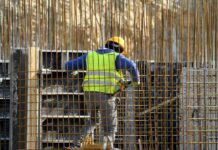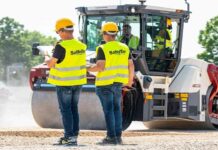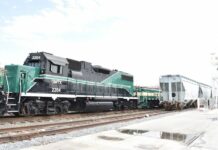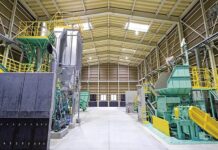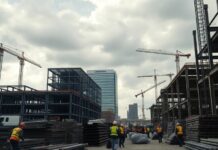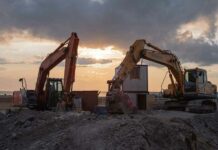Introduction
The construction industry is inherently risky, from towering scaffolds to heavy machinery and hazardous materials. Ensuring a safe and efficient work environment on construction sites is paramount, not only for the well-being of workers but also for the successful completion of projects. Neglecting essential safety measures and efficiency protocols can lead to disastrous consequences, including injuries, fatalities, costly delays, and legal repercussions.
This article will delve into seven indispensable items that every construction zone must possess to cultivate a secure and streamlined operation. From personal protective equipment to communication channels and emergency response measures, these seven pillars form the foundation of a robust safety and efficiency framework. By prioritizing their implementation, construction firms can mitigate risks, optimize productivity, and foster a culture of accountability and proactivity.
Safety Gear
Properly utilizing personal protective equipment (PPE) is the cornerstone of any construction site’s safety protocol. These specialized garments and accessories serve as the first line of defense against many potential hazards, shielding workers from harm and enabling them to perform their tasks confidently.
Hard hats, ubiquitous on construction sites, are designed to safeguard workers from falling debris, overhead obstructions, and impact injuries. Constructed from durable materials like high-density polyethylene, these helmets can withstand significant force, potentially preventing severe head trauma or saving lives.
Safety glasses or goggles are equally crucial, protecting workers’ eyes from airborne particles, flying fragments, and harmful ultraviolet radiation. These specialized lenses are often impact-resistant and feature anti-fog coatings to ensure clear visibility in challenging environments.
Footwear is another vital component of PPE, with steel-toed boots or shoes offering robust protection against falling objects, punctures, and slips. These sturdy footwear options feature reinforced toe caps and slip-resistant soles and often incorporate additional safety features like metatarsal guards or electrical hazard protection.
Flame-resistant clothing, or FR apparel, is essential for workers operating in environments with potential fire hazards. These garments are designed to self-extinguish rapidly, minimizing the risk of severe burns or clothing ignition. FR apparel is particularly crucial in welding, metalworking, and petrochemical operations.
While the specific PPE requirements may vary based on the nature of the work and potential hazards, construction sites must provide workers with appropriate gear and enforce its proper usage. Regular inspections, maintenance, and replacements should be conducted to ensure the equipment’s effectiveness.
Signage and Communication
Effective communication is the lifeblood of any successful construction operation, and clear signage plays a pivotal role in conveying vital information, promoting awareness, and guiding workers and visitors alike. Highly visible and strategically placed signage can streamline traffic flow, delineate hazardous areas, and provide essential safety instructions, ultimately contributing to a more organized and efficient work environment.
Traffic control signage, such as stop signs, yield signs, and directional markers, are crucial for regulating the movement of vehicles and pedestrians within the construction zone. These signs help prevent collisions, minimize confusion, and ensure a smooth traffic flow, reducing the risk of accidents and delays
Safety signage, including warnings, cautions, and instructional signs, constantly reminds workers to remain vigilant and follow established protocols. These signs can highlight potential hazards, such as falling object zones, confined spaces, or areas requiring specific PPE, reinforcing a culture of safety and risk awareness.
Beyond visual cues, open and effective communication channels are essential for coordinating activities, disseminating updates, and addressing any concerns or issues that may arise. Regular meetings, toolbox talks, and clear lines of communication between supervisors, workers, and subcontractors can foster a collaborative environment, promote transparency, and enable swift responses to evolving situations.
Furthermore, leveraging modern communication technologies, such as two-way radios, can enhance coordination, facilitate real-time information sharing, and improve emergency response times. By prioritizing clear signage and fostering open communication, construction sites can cultivate a safer, more efficient, and well-informed workforce.
Emergency Response Equipment
While stringent safety measures and proactive planning can minimize the occurrence of emergencies on construction sites, being prepared for the unexpected is crucial. Having readily accessible emergency response equipment can mean the difference between a minor incident and a catastrophic event, ensuring the well-being of workers and minimizing potential damage.
Fire extinguishers are among the most essential emergency response tools. Fires can ignite swiftly in environments with combustible materials and electrical hazards. Strategically placed and properly maintained fire extinguishers can enable rapid response and containment, potentially preventing a small fire from escalating into a devastating blaze.
First-aid kits are another vital component of emergency preparedness. Well-stocked with bandages, gauze, antiseptics, and other medical supplies, these kits can immediately assist minor injuries or stabilize more severe conditions until professional medical attention arrives.
In addition to physical equipment, clearly displayed emergency contact information and established procedures can expedite emergency services’ response time. Prominently posting the phone numbers for local fire departments, ambulance services, and other relevant authorities can ensure swift action in critical situations.
Regular training and drills for workers on properly using emergency response equipment and procedures are equally important. By fostering familiarity and confidence in handling emergencies, construction sites can cultivate a proactive mindset and promote a culture of preparedness, ultimately enhancing the safety and resilience of the entire operation.
Lighting and Illumination
Proper lighting and illumination are essential for ensuring visibility and safety and facilitating efficient work progress on construction sites. Inadequate lighting can lead to accidents, errors, and potential hazards, while optimal illumination can enhance productivity, accuracy, and overall site efficiency.
During daytime operations, natural lighting may suffice for certain tasks. However, areas with limited natural light or enclosed spaces may require supplemental lighting solutions. Portable lights, such as halogen or LED work lights, can be strategically positioned to illuminate work areas and ensure workers’ visibility.
Temporary or permanent lighting fixtures become indispensable in nighttime or low-light conditions. Portable generators can power an array of lighting equipment, enabling continuous operations and ensuring worker safety during non-daylight hours.
In addition to general area lighting, task-specific lighting may be necessary for intricate or detailed work. Headlamps or specialized task lights can provide focused illumination, minimizing eye strain and improving accuracy.
Factors such as brightness, glare reduction, and energy efficiency should be considered when selecting lighting solutions. Proper placement and appropriate light levels can enhance visibility while minimizing shadows or harsh contrasts that can cause eye fatigue or obscure potential hazards.
By prioritizing lighting and illumination, construction sites can foster a safer and more productive work environment. This will enable workers to perform their tasks with confidence and accuracy, regardless of ambient light conditions.
Proper Tools and Equipment
A construction site is a dynamic environment that demands various tools and equipment to execute multiple tasks. Ensuring that workers have access to the proper tools and equipment is essential for safety and maintaining efficiency and productivity.
Using the right tool for the job can significantly reduce the risk of accidents and injuries. Attempting to force a tool beyond its intended purpose or relying on makeshift solutions can lead to tool failure, potential harm to workers, and subpar work quality.
Construction sites should maintain a comprehensive inventory of tools and equipment tailored to the project’s specific needs. From power tools like drills, saws, and nail guns to specialized equipment like jackhammers, concrete mixers, and lifting machinery, having the appropriate tools on hand can streamline workflows and minimize potential hazards.
Regular maintenance and inspection of tools and equipment are equally crucial. Worn or damaged tools can pose significant risks and compromise efficiency. Implementing a structured maintenance program, including routine inspections, repairs, and replacements, can ensure that tools remain in optimal working condition, reducing downtime and fostering a safer working environment.
Additionally, providing proper training and certification for workers on safely operating specialized tools and equipment is paramount. Inadequate knowledge or improper use can lead to accidents, injuries, and potential legal liabilities.
By prioritizing proper tools and equipment, construction sites can cultivate a culture of safety, efficiency, and professionalism, where workers have the resources to execute tasks effectively while minimizing risks and maximizing productivity.
Waste Management and Disposal
Construction activities inevitably generate significant waste, ranging from debris and packaging materials to hazardous substances and chemical byproducts. Effective waste management and disposal practices are crucial for maintaining a clean, safe, and compliant work environment.
Designated waste disposal areas, clearly marked and strategically located, should be established on construction sites. These areas should be equipped with appropriate containers or dumpsters for separating and storing different types of waste, such as wood, metal, concrete, and hazardous materials.
Proper waste handling and disposal protocols should be implemented to ensure compliance with local, state, and federal regulations. This includes adhering to guidelines for safely disposing of hazardous materials, such as asbestos, lead-based paints, and chemical solvents, which can pose significant health and environmental risks if mishandled.
Responsible waste management practices extend beyond mere disposal. Implementing waste reduction strategies, such as recycling and reusing materials whenever possible, can contribute to a more sustainable and environmentally conscious construction process.
Regular waste removal and site cleanup should be scheduled to prevent the accumulation of debris, which can create tripping hazards, obstruct access routes, and contribute to an overall disorganized and unsafe work environment.
By prioritizing waste management and disposal, construction sites can maintain a clean and organized workspace, minimize potential hazards, comply with regulations, and promote a more sustainable and environmentally responsible approach to construction operations.
Dust Control Measures
Construction activities often generate significant amounts of dust and airborne particulates, posing severe health risks to workers if not adequately controlled. Implementing effective dust control measures is crucial for maintaining a safe and healthy work environment and minimizing potential environmental impacts.
One of the most commonly employed dust control methods is water spraying. By applying a fine mist or water spray to areas where dust is generated, such as demolition sites, excavations, or material handling zones, the water can effectively suppress airborne particulates, preventing them from becoming a respiratory hazard.
Dust control barriers, such as fencing or temporary enclosures, can also contain dust within specific areas, minimizing its spread and preventing it from reaching nearby locations or public spaces.
Proper ventilation is another essential component of dust control. Ensuring adequate air circulation and installing localized exhaust systems can help remove airborne particulates from enclosed spaces, preventing the buildup of hazardous dust concentrations.
In addition to physical dust control measures, administrative controls, such as worker training and personal protective equipment (PPE) like respirators, can further mitigate the risks associated with dust exposure.
By implementing comprehensive dust control strategies, construction sites can create a healthier and safer working environment, protect workers from respiratory illnesses and other health hazards, and minimize the environmental impact of their operations.
Conclusion
The seven must-have items – safety gear, signage and communication, emergency response equipment, lighting and illumination, proper tools and equipment, waste management and disposal, and dust control measures – are the foundation of a safe, efficient, and responsible construction operation. Implementing these essential elements safeguards workers’ well-being, contributes to successful project completion, minimizes delays, and fosters a culture of accountability and professionalism in the industry. By embracing these seven pillars, construction firms cultivate an environment emphasizing safety, efficiency, and sustainability, ultimately enhancing their reputation and competitiveness. As the industry advances, an unwavering commitment to creating construction zones prioritizing worker well-being and excellence is imperative.







